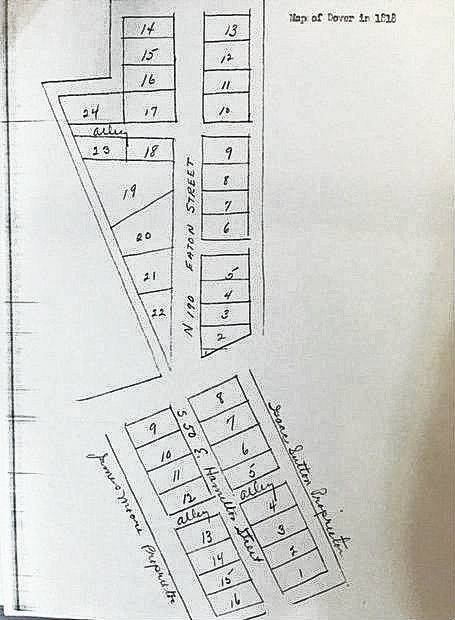
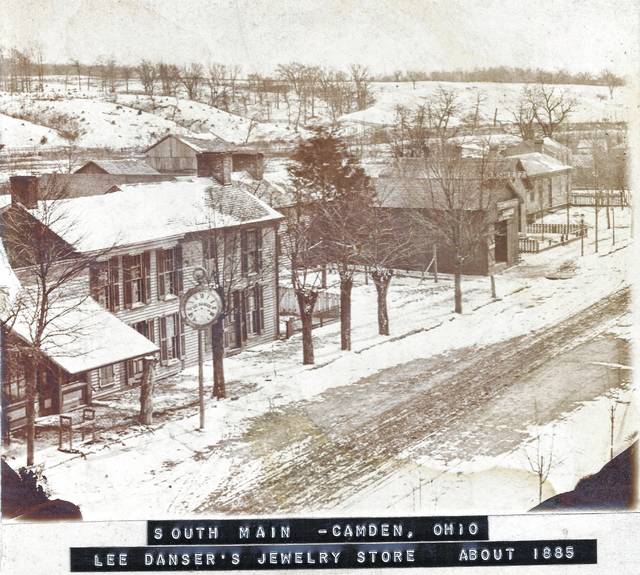
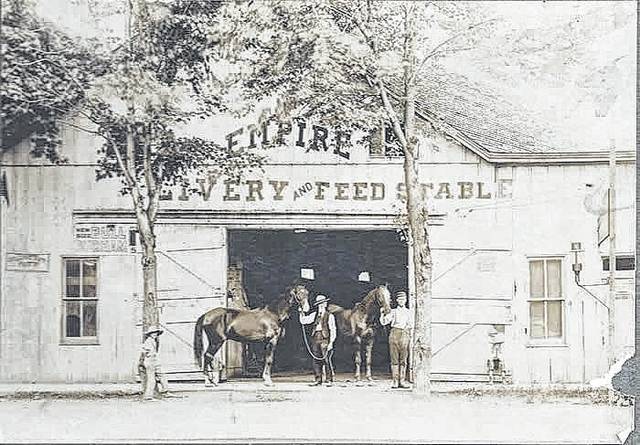
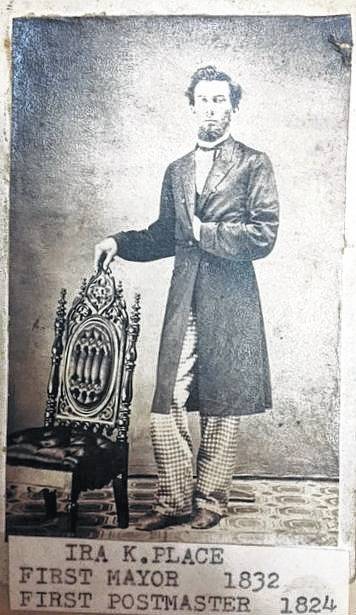
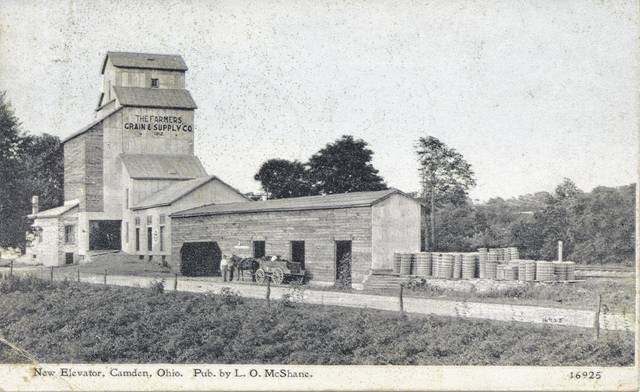
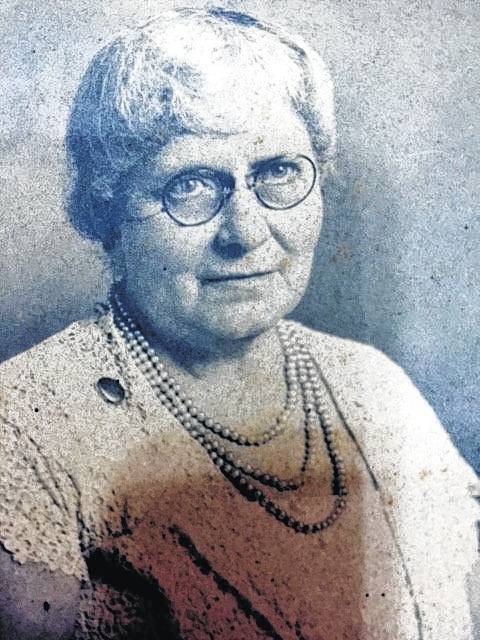
CAMDEN — This week, we start a year-long, twice-monthly series of articles leading up to Camden, Ohio’s Bicentennial Celebration in the summer of 2018. The series will highlight the funny, interesting stories of the town’s rich and colorful history.
You’ll hear about the obvious topics — the town’s beginning, successful businesses and Sherwood Anderson. You’ll also learn about our renowned world-class opera star; how women impacted the town over the years; Camden’s murders, mysteries, and mayhem; prohibition and its effect on Camden’s popular tavern culture; fires, floods and other disasters, oh my; and the village’s important role in Preble County history.
So, let’s start at the beginning. The David E. Hendricks family were the first folks to arrive in 1803 to the valley area formerly occupied by Native Americans. Soon, the availability of land and forests around Seven Mile Creek attracted more settlers. By 1818, the growing numbers dictated organization and the village of Dover (now Camden) was created. The official description and plot for the town was recorded on July 4, 1818.
When a post office was established in 1824, the townsfolk learned another village called Dover had claimed the name in Ohio, so the village changed to Newcomb (honoring then State Senator George Newcomb). The village grew and with new settlers came a continual stream of new businesses. In 1831, the town was incorporated. Mr. Ira K. Place, who had been the town’s first postmaster became the town’s first , and village councilmen and officers where soon appointed.
Following Newcomb’s incorporation, the community’s infrastructure and outside interest continued to increase. Buildings, churches and schools were erected right and left, neighboring towns of Eaton and Gratis were also growing, and Newcomb proved to be a hip and happening little place to live. At least by 19th century standards.
The name Newcomb never really caught on and according to early accounts, one section of the village continued to call itself Dover. So in 1835, the village changed its name to Camden, chosen to honor Revolutionary War battle site, Camden, South Carolina. And the new name finally stuck.
Businesses thrived, the rich farmland proved bountiful, and population soared. By the late 1800’s, a local Camden writer—identified only as Moses—wrote this in a letter to the editor of the Eaton Democrat newspaper:
“Camden contains a population of about 800, having 3 dry good stores, 3 groceries, 1 bakery, 2 taverns, 1 drug store, 3 physicians, 3 shoe shops, 3 tailoring establishments, 3 blacksmith shops, 2 saddlers, 1 carriage manufactory, one tinner, one millner, a mantumaker, five cooper shops in which latter branch of business alone a capital of $10,000 is annually employed. There are near the town, 2 carding and fulling mills, five merchants, and seven saw mills all located on that well known stream call Seven Mile.”
The village was prospering. And it showed. By 1936, The Dayton Daily News would describe Camden this way, “Highest Standards of citizenship and enterprise of the good old Quaker type have served to make Camden a rich gem in Ohio’s brilliant crown of splendid municipalities.”
A splendid municipality indeed. Over the years, visitors would come from near and far by foot, buggy, train and car to attend first-class concerts and events at Camden’s Town Hall or Bennett’s Opera house, for roller skating at the Jumbo mill, to stay at one of five hotels, eat – or drink – at the town’s restaurants or taverns, attend a movie at one of two theaters, to play the games and dare the rides at the annual homecoming carnivals, to see President William Taft give a re-election speech when his train stopped at Camden’s depot, or more recently for the good food and great buys found at the Black Walnut Festival.
Shoppers arrived in Camden eager to browse the latest merchandise at Collet and Son’s Clothing, Caskey’s Furniture, White’s Department Store, or Shank’s Variety. Or to purchase necessities and a root beer float at Webb’s Drug Store, a new Ford at Day’s, to eat at Harvey’s or to get a haircut at Olive’s Beauty Salon or Floyd’s barbershop. To name just a few.
We’ll be covering lots of stories about Camden’s first 200 years—its people, places, businesses and events—in the Register Herald throughout the coming year. In the meantime, you can find more photos and stories at our www.facebook.com/CamdenOHBicentennial2018 page.
For now, I leave you with part of a poem written by Camden native Elizabeth Acton Ecker in 1916 about her beloved hometown.
Camden (by Elizabeth Acton Ecker)
Just a quiet little hamlet
Tucked so snug between the hills,
On the banks of dear old Seven Mile
With its many sparkling rills.
Long ago, when danger threatened
Back some hundred years or over
In the midst of virgin forests
It then bore the name of Dover.
Now with pride we watch its progress,
Watch it keep along in line
With all modern improvements,
Which appear from time to time
Sure it’s just a friendly village,
Never has been known to boast
Prithee: many she is proud of
Can be found from coast to coast.
From her fold e’en tho they wander
And continue still to roam
When they’re sad, their hearts yet claim it
As in childhood, still their home.
(Note: A special thank-you to the current staff of the Camden Archives for their assistance in researching our stories and to Camden historians past and present for preserving so many precious memories.)







